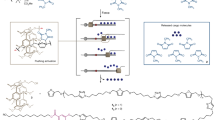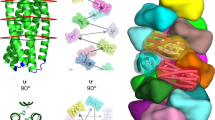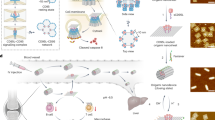Abstract
DNA has traditionally been used for the programmable design of nanostructures by exploiting its sequence-defined supramolecular recognition. However, control on larger length scales or even hierarchical materials that translate to the macroscale remain difficult to construct. Here, we show that the polymer character of single-stranded DNA (ssDNA) can be activated via a nucleobase-specific lower critical solution temperature, which provides a unique access to mesoscale structuring mechanisms on larger length scales. We integrate both effects into ssDNA multiblock copolymers that code sequences for phase separation, hybridization and functionalization. Kinetic pathway guidance using temperature ramps balances the counteracting mesoscale phase separation during heating with nanoscale duplex recognition during cooling to yield a diversity of complex all-DNA colloids with control over the internal dynamics and of their superstructures. Our approach provides a facile and versatile platform to add mesostructural layers into hierarchical all-DNA materials. The high density of addressable ssDNA blocks opens routes for applications such as gene delivery, artificial evolution or spatially encoded (bio)materials.
This is a preview of subscription content, access via your institution
Access options
Access Nature and 54 other Nature Portfolio journals
Get Nature+, our best-value online-access subscription
$29.99 / 30 days
cancel any time
Subscribe to this journal
Receive 12 print issues and online access
$259.00 per year
only $21.58 per issue
Buy this article
- Purchase on Springer Link
- Instant access to full article PDF
Prices may be subject to local taxes which are calculated during checkout






Similar content being viewed by others
References
Whitesides, G. M. & Grzybowski, B. Self-assembly at all scales. Science 295, 2418–2421 (2002).
Tschierske, C. Development of structural complexity by liquid-crystal self-assembly. Angew. Chem. Int. Ed. 52, 8828–8878 (2013).
Rothemund, P. W. K. Folding DNA to create nanoscale shapes and patterns. Nature 440, 297–302 (2006).
Dietz, H., Douglas, S. M. & Shih, W. M. Folding DNA into twisted and curved nanoscale shapes. Science 325, 725–730 (2009).
Douglas, S. M. et al. Self-assembly of DNA into nanoscale three-dimensional shapes. Nature 459, 414–418 (2009).
Jones, M. R., Seeman, N. C. & Mirkin, C. A. Programmable materials and the nature of the DNA bond. Science 347, 1260901 (2015).
Wagenbauer, K. F., Sigl, C. & Dietz, H. Gigadalton-scale shape-programmable DNA assemblies. Nature 552, 78–83 (2017).
Wilner, O. I. et al. Enzyme cascades activated on topologically programmed DNA scaffolds. Nat. Nanotech. 4, 249–254 (2009).
Mirkin, C. A., Letsinger, R. L., Mucic, R. C. & Storhoff, J. J. A DNA-based method for rationally assembling nanoparticles into macroscopic materials. Nature 382, 607–609 (1996).
Zhao, H. et al. Reversible trapping and reaction acceleration within dynamically self-assembling nanoflasks. Nat. Nanotech. 11, 82–88 (2016).
Edwardson, T. G. W., Carneiro, K. M. M., McLaughlin, C. K., Serpell, C. J. & Sleiman, H. F. Site-specific positioning of dendritic alkyl chains on DNA cages enables their geometry-dependent self-assembly. Nat. Chem. 5, 868–875 (2013).
Schnitzler, T. & Herrmann, A. DNA block copolymers: functional materials for nanoscience and biomedicine. Acc. Chem. Res. 45, 1419–1430 (2012).
Alemdaroglu, F. E. & Herrmann, A. DNA meets synthetic polymers—highly versatile hybrid materials. Org. Biomol. Chem. 5, 1311–1320 (2007).
Um, S. H. et al. Enzyme-catalysed assembly of DNA hydrogel. Nat. Mater. 5, 797–801 (2006).
Liao, W.-C. & Willner, I. Synthesis and applications of stimuli-responsive DNA-based nano- and micro-sized capsules. Adv. Funct. Mater. 27, 1702732 (2017).
Lee, J. B., Hong, J., Bonner, D. K., Poon, Z. & Hammond, P. T. Self-assembled RNA interference microsponges for efficient siRNA delivery. Nat. Mater. 11, 316–322 (2012).
Ducrot, E., He, M., Yi, G. R. & Pine, D. J. Colloidal alloys with preassembled clusters and spheres. Nat. Mater. 16, 652–657 (2017).
Qi, H. et al. DNA-directed self-assembly of shape-controlled hydrogels. Nat. Commun. 4, 2275 (2013).
Zelikin, A. N. et al. A general approach for DNA encapsulation in degradable polymer microcapsules. ACS Nano 1, 63–69 (2007).
Ong, L. L. et al. Programmable self-assembly of three-dimensional nanostructures from 10,000 unique components. Nature 552, 72–77 (2017).
Tikhomirov, G., Petersen, P. & Qian, L. Fractal assembly of micrometre-scale DNA origami arrays with arbitrary patterns. Nature 552, 67–71 (2017).
Groeschel, A. H. et al. Precise hierarchical self-assembly of multicompartment micelles. Nat. Commun. 3, 710 (2012).
Bates, F. S. Polymer–polymer phase-behavior. Science 251, 898–905 (1991).
Qiu, H. B., Hudson, Z. M., Winnik, M. A. & Manners, I. Multidimensional hierarchical self-assembly of amphiphilic cylindrical block comicelles. Science 347, 1329–1332 (2015).
Stuart, M. A. C. et al. Emerging applications of stimuli-responsive polymer materials. Nat. Mater. 9, 101–113 (2010).
Aseyev, V., Tenhu, H. & Winnik, F. M. Self Organized Nanostructures of Amphiphilic Block Copolymers II (Springer, Berlin Heidelberg, 2011).
Heuser, T., Merindol, R., Loescher, S., Klaus, A. & Walther, A. Photonic devices out of equilibrium: transient memory, signal propagation, and sensing. Adv. Mater. 29, 9807–9814 (2017).
Groeschel, A. H. et al. Guided hierarchical co-assembly of soft patchy nanoparticles. Nature 503, 247–251 (2013).
Lyon, L. A., Meng, Z. Y., Singh, N., Sorrell, C. D. & St John, A. Thermoresponsive microgel-based materials. Chem. Soc. Rev. 38, 865–874 (2009).
Lutz, J. F., Ouchi, M., Liu, D. R. & Sawamoto, M. Sequence-controlled polymers. Science 341, 1238149 (2013).
Blanco, L. et al. Highly efficient DNA-synthesis by the phage Φ29 DNA polymerase. J. Biol. Chem. 264, 8935–8940 (1989).
Ali, M. M. et al. Rolling circle amplification: a versatile tool for chemical biology, materials science and medicine. Chem. Soc. Rev. 43, 3324–3341 (2014).
Nelissen, F. H. T., Goossens, E. P. M., Tessari, M. & Heus, H. A. Enzymatic preparation of multimilligram amounts of pure single-stranded DNA samples for material and analytical sciences. Anal. Biochem. 475, 68–73 (2015).
Estévez-Torres, A. & Baigl, D. DNA compaction: fundamentals and applications. Soft Matter 7, 6746–6756 (2011).
Bomboi, F. et al. Re-entrant DNA gels. Nat. Commun. 7, 13191 (2016).
Duguid, J. G. & Bloomfield, V. A. Aggregation of melted DNA by divalent metal ion-mediated cross-linking. Biophys. J. 69, 2642–2648 (1995).
Zozulya, V. N., Nesterov, A. B., Ryazanova, O. A. & Blagoi, Y. P. Conformational transitions and aggregation in poly(dA)-poly(dT) system induced by Na+ and Mg2+ ions. Int. J. Biol. Macromolec. 33, 183–191 (2003).
Kohno, Y., Saita, S., Men, Y. J., Yuan, J. Y. & Ohno, H. Thermoresponsive polyelectrolytes derived from ionic liquids. Polym. Chem. 6, 2163–2178 (2015).
Plamper, F. A., Schmalz, A., Ballauff, M. & Mueller, A. H. E. Tuning the thermoresponsiveness of weak polyelectrolytes by pH and light: lower and upper critical-solution temperature of poly(N,N-dimethylaminoethyl methacrylate). J. Am. Chem. Soc. 129, 14538–14539 (2007).
Elbert, D. L. Liquid–liquid two-phase systems for the production of porous hydrogels and hydrogel microspheres for biomedical applications: A tutorial review. Acta Biomater. 7, 31–56 (2011).
Zheng, H., Shabalin, I. G., Handing, K. B., Bujnicki, J. M. & Minor, W. Magnesium-binding architectures in RNA crystal structures: validation, binding preferences, classification and motif detection. Nucleic Acids Res. 43, 3789–3801 (2015).
Zavitsas, A. A. Aqueous solutions of calcium ions: hydration numbers and the effect of temperature. J. Phys. Chem. B 109, 20636–20640 (2005).
Yatsunyk, L. A., Mendoza, O. & Mergny, J.-L. 'Nano-oddities': unusual nucleic acid assemblies for DNA-based nanostructures and nanodevices. Acc. Chem. Res. 47, 1836–1844 (2014).
Rippe, K., Fritsch, V., Westhof, E. & Jovin, T. M. Alternating d(G-A) sequences form a parallel-stranded DNA homoduplex. EMBO J. 11, 3777–3786 (1992).
Szostak, J. W., Bartel, D. P. & Luisi, P. L. Synthesizing life. Nature 409, 387–390 (2001).
Rodriguez-Arco, L., Li, M. & Mann, S. Phagocytosis-inspired behaviour in synthetic protocell communities of compartmentalized colloidal objects. Nat. Mater. 16, 857–863 (2017).
Park, S. Y. et al. DNA-programmable nanoparticle crystallization. Nature 451, 553–556 (2008).
Wang, Y. et al. Crystallization of DNA-coated colloids. Nat. Commun. 6, 7253 (2015).
Baffou, G. & Quidant, R. Thermo-plasmonics: using metallic nanostructures as nano-sources of heat. Laser Photon. Rev. 7, 171–187 (2013).
Mura, S., Nicolas, J. & Couvreur, P. Stimuli-responsive nanocarriers for drug delivery. Nat. Mater. 12, 991–1003 (2013).
Shanmugam, V., Selvakumar, S. & Yeh, C. S. Near-infrared light-responsive nanomaterials in cancer therapeutics. Chem. Soc. Rev. 43, 6254–6287 (2014).
Willner, I., Shlyahovsky, B., Zayats, M. & Willner, B. DNAzymes for sensing, nanobiotechnology and logic gate applications. Chem. Soc. Rev. 37, 1153–1165 (2008).
Merindol, R. & Walther, A. Materials learning from life: concepts for active, adaptive and autonomous molecular systems. Chem. Soc. Rev. 46, 5588–5619 (2017).
Hyman, A. A., Weber, C. A. & Juelicher, F. Liquid–liquid phase separation in biology. Annu. Rev. Cell Dev. Biol. 30, 39–58 (2014).
Acknowledgements
This work was funded via the ERC Starting Grant TimeProSAMat (677960). S.L. is funded through a scholarship of the FCI. We thank A. Kuehne for critically reading the manuscript.
Author information
Authors and Affiliations
Contributions
R.M. and A.W. conceived the project, designed the experiments and analysed the data. R.M., S.L. and A.S. carried out the experiments. A.W. supervised the project. R.M. and A.W. wrote the manuscript.
Corresponding author
Ethics declarations
Competing interests
The authors declare no competing interests.
Additional information
Publisher’s note: Springer Nature remains neutral with regard to jurisdictional claims in published maps and institutional affiliations.
Supplementary information
Supplementary Information
Supplementary Text, Supplementary Figures 1–8, Supplementary Table 1 and Supplementary References
Supplementary Video 1
Photobleaching of crosslinked core–shell all-DNA microgels
Supplementary Video 2
Photobleaching of core–shell all-DNA protocells with liquid DNA core
Supplementary Video 3
Photothermal ejection of ssDNA from core–shell all-DNA protocells with liquid DNA core and Au-NPs embedded inside the shells
Rights and permissions
About this article
Cite this article
Merindol, R., Loescher, S., Samanta, A. et al. Pathway-controlled formation of mesostructured all-DNA colloids and superstructures. Nature Nanotech 13, 730–738 (2018). https://doi.org/10.1038/s41565-018-0168-1
Received:
Accepted:
Published:
Issue Date:
DOI: https://doi.org/10.1038/s41565-018-0168-1
This article is cited by
-
Self-assembly of stabilized droplets from liquid–liquid phase separation for higher-order structures and functions
Communications Chemistry (2024)
-
DNA as a universal chemical substrate for computing and data storage
Nature Reviews Chemistry (2024)
-
Superstructural ordering in self-sorting coacervate-based protocell networks
Nature Chemistry (2024)
-
RNAs undergo phase transitions with lower critical solution temperatures
Nature Chemistry (2023)
-
Signal-processing and adaptive prototissue formation in metabolic DNA protocells
Nature Communications (2022)



